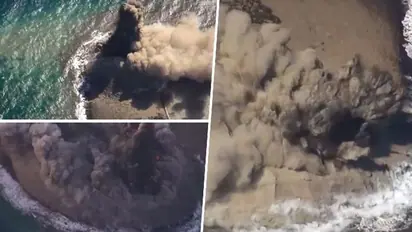1st emergence since 1986! Underwater volcanic eruptions form new island off Japan's Ogasawara coast (WATCH)

Synopsis
Eruptions from an underwater volcano create a new island off the coast of Japan in the Ogasawara island chain, marking the first such occurrence in the region since 1986.
An undersea volcano's eruptions near Japan's Ogasawara island chain have given rise to a new islet in the Pacific Ocean, over 1,000 kilometers south of Tokyo. As reported by Asahi Shimbun, the emergence of this new island, which lies in the vicinity of the Iwojima Island (Iwoto Island) famous for its Second World War history, occurred on November 1. The personnel stationed on Iwojima reported hearing a loud noise and observed sand being propelled high into the air, a consequence of the formation of the new island.
According to the Japan Meteorological Agency (JMA), seismic activity has been detected on Iwoto Island since October 21, signaling the onset of volcanic eruptions, leading to the recent event.
This new islet took shape close to the crater of the underwater volcano. An official from JMA speculated that the accumulation of rocks and stones expelled from the seafloor crater contributed to the formation of the islet.
Historically, similar incidents have occurred in the region resulting in the emergence of new islands, but the harsh sea conditions have led to their subsequent submersion within months.
Remarkably, this newly formed islet stands as the first occurrence of its kind in the region since 1986.
Continuous volcanic activity has prompted officials to caution about potential smoke and substantial ash deposition in the surrounding area.
In a separate development earlier this year, Japan's Geospatial Information Authority reported the discovery of about 7,000 new islands around the country through digital mapping, marking the first extensive survey of its kind in 35 years. Despite these discoveries, the total territorial size of Japan, which spans 37,000 square kilometers, remains unaffected.
Check the Breaking News Today and Latest News from across India and around the world. Stay updated with the latest World News and global developments from politics to economy and current affairs. Get in-depth coverage of China News, Europe News, Pakistan News, and South Asia News, along with top headlines from the UK and US. Follow expert analysis, international trends, and breaking updates from around the globe. Download the Asianet News Official App from the Android Play Store and iPhone App Store for accurate and timely news updates anytime, anywhere.